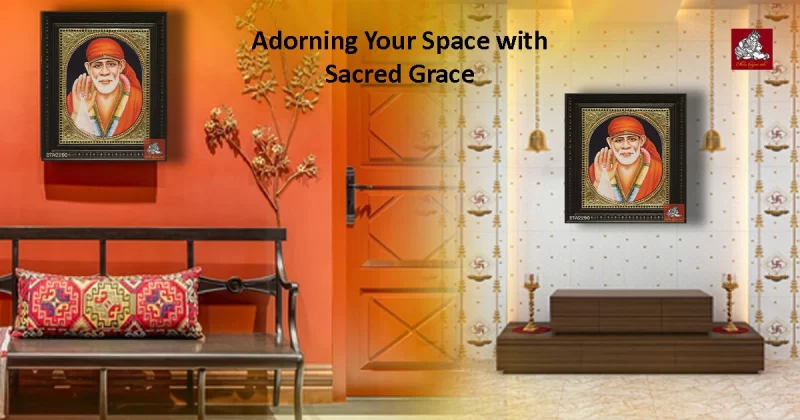Tanjore Art has a rich history of heritage and culture from Tamil Nadu and acts as an example of the artistic culture of India. Ethnic Tanjore Art is known for its exclusive form of craftsmanship, use of vibrant colors, and deep spiritual themes. Among the myriad subjects immortalized in Tanjore art, the depiction of revered saints and divine beings holds a special place.
Sai Baba of Shirdi is one such revered figure whose presence graces many Tanjore paintings. This blog covers the advantages of having Sai Baba Tanjore painting in your pooja room. Kindly find time to explore this blog to learn more about Sai Baba Tanjore’s Art.
History of Sai Baba:
One of the most venerated saints in India, Sai Baba of Shirdi, also called Shirdi Sai Baba, is well-known for his teachings on self-realization, love, and compassion. His unique life and spiritual legacy are revealed through historical sources and oral traditions, even though much of it is still veiled in mystery and myth.

Though his exact birthdate and location are unknown, Sai Baba is thought to have been born in the early to mid-19th century. He was born and raised in the Indian state of Maharashtra, in the little village of Shirdi. Sai Baba’s early life, including his parents and boyhood, is little known. Some stories claim that he was raised by a Muslim fakir (saint), Gopal Rao Deshmukh, after being adopted by his Hindu parents.
Some others think a Muslim couple adopted him after being born into a Brahmin family. Sai Baba was raised with strong spiritual convictions and a strong feeling of disengagement from material matters, regardless of his background.
Exploring the Symbolism in Sai Baba:
Symbolism in Sai Baba’s persona and teachings unveils layers of spiritual wisdom and universal truths. Here are some aspects of Sai Baba’s Symbolism:
Simple Attire and Appearances – Sai Baba’s attire consists of a simple white robe and head covering, which symbolizes humility, renunciation, and detachment from worldly possessions.
The Sacred Fire: Sai Baba maintained a sacred fire in the Dwarkamai Mosque, symbolizing the eternal flame of divine consciousness.
The Begging Bowl – Sai Baba often carried a small begging bowl symbolizing the virtue of simplicity and accepting whatever life offers with gratitude.
Universal Love and Compassion – Transcending the boundaries of religion, Sai Baba’s teachings emphasize the university of love and compassion. His acceptance embraces all beings symbolizing the oneness of humanity and inherants every soul.
The Practice of Selfless Service – Sai Baba taught the value of selfless service as a means of achieving spiritual development while serving humanity selflessly, regardless of background or social standing.
Analyzing the symbolism in Sai Baba’s life and teachings provides a deep understanding of the universal ideals of love, compassion, and self-realization that Sai Baba symbolizes as well as the everlasting spiritual truths.
Tanjore Art: A Testament to Tradition:
Thanjavur painting, another name for Tanjore art, is a symbol of the rich artistic and cultural legacy of southern India. This centuries-old art style, which has its roots in the Indian state of Tamil Nadu’s town of Thanjavur (Tanjore), has enthralled both art fans and spiritual seekers with its beautiful beauty, minute detailing, and deep spiritual meaning.
- Historical Roots:
The Nayakas of Thanjavur, who were renowned patrons of the arts and culture, ruled Thanjavur during the 16th century when Tanjore art first emerged.
- Distinctive Features:
Rich, vivid hues, elaborate embellishments, and the use of priceless materials like gold foil and semi-precious stones distinguish Tanjore art from other forms of art.
- Spiritual Significance:
Tanjore art is fundamentally a very spiritual form of expression that conveys the devotee’s respect and devotion to the holy, rather than just being an artistic endeavor.
- Preservation and Revival:
Tanjore art has endured throughout the ages due to both shifting aesthetic preferences and financial limitations. To preserve and restore this historic art form’s legacy for upcoming generations to value and cherish, committed artists and cultural enthusiasts have labored nonstop to preserve and restore it.
As we marvel at the splendor of Tanjore art, we are invited to journey into the heart of India’s artistic legacy, where tradition and spirituality converge in a dazzling display of beauty and devotion.
Adorning Your Space with Sacred Grace:
In the realm of spiritual adornment, a powerful way to invite Sai Baba’s benevolent presence into your life by adorning your space with sacred art dedicated to him can infuse your surroundings with spiritual grace and upliftment.
- The Spiritual Essence of Sai Baba:
Sai Baba of Shirdi, a revered saint who lived in the late 19th century and early 20th century, personified the highest qualities of compassion, love, and selflessness. His teachings, which emphasized the universal values of faith, humility, and devotion to the almighty, cut beyond the borders of religion and caste.
- Sacred Art as the Gateway to Divine:
Sacred art is a potent means of establishing a connection with the divine and attracting blessings into one’s life, according to Indian spiritual tradition. Paintings from Tanjore, in particular, are highly valued for their spiritual meaning and stunning beauty.
- Embracing the Presence of Sai Baba:
A Tanjore artwork of Sai Baba on your wall or in a hallowed place will serve as a focus point for meditation, prayer, and introspection. His loving presence nurtures your spirit and strengthens your bond with the divine, acting as a continual source of inspiration and direction.
Adding the Sacred Artwork of Sai Baba to your home is the practice that brings divine presence into your life and fills your environment with spiritual grace and benefits.
Conclusion:
Adding a touch of divine grace and sacred magnificence, whether it is hung in a place of worship, office, or meditation area. May Sai Baba’s loving embrace and blessings surround you as you beautify your environment with these timeless masterpieces, leading you on a road of inner fulfillment and spiritual awareness. The atmosphere of any location can be changed by Sai Baba Tanjore art.

